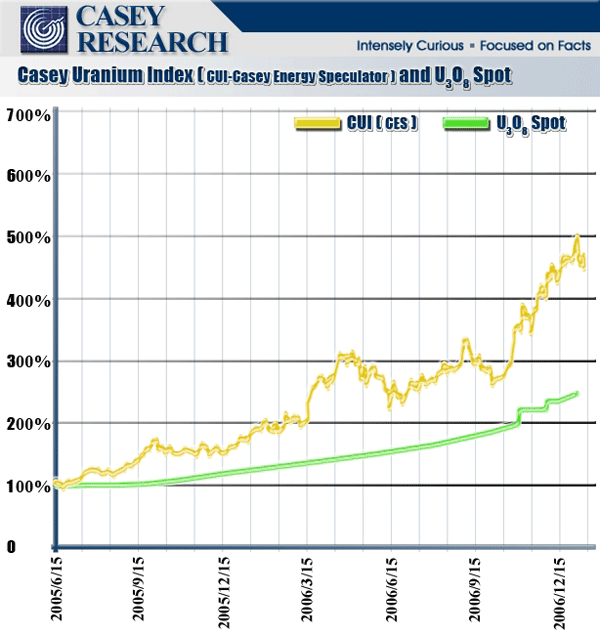Profiting from the uranium bull market
When the fundamentals of uranium first caught my eye back in 1998, says Doug Casey, it was a contrarian’s dream...
AT THE TIME it was, to my thinking at least, the proverbial manna, an ultra-clean, ultra-safe, ultra-efficient and virtually unlimited source of mass energy, yet due to environmental hysteria was viscerally and universally despised.
Its price had fallen to only about $9.00 on its way even lower, a price that made it uneconomic to produce, let alone explore for. As a result, there was a huge and growing short-fall in new mine production to meet demand. That short-fall was largely covered by reprocessing nuclear weapons, mostly from the former Soviet Union, but it was clear to me that that supply was finite, whereas demand was not.
A lot has happened since my first recommendation of uranium, or, more specifically, uranium stocks, back in 1998. Including, I am happy to say, my subscribers and I have made a lot of money (click here to learn more...). That is the reward for being early into a trend.
But the trend has now been in motion for some time, and so it is worth revisiting.
Is the big up-move in uranium prices over? Can you still find good value in uranium stocks? Marin Katusa, a uranium analyst here at Casey Research recently took on the task of answering those questions, the results of which follow. If you are invested in uranium stocks at the moment, or are thinking about it, you owe it to yourself to read on.
Doug Casey
Profiting from the Next Phase of the Uranium Bull Market
by Marin Katusa
WITH THE SPOT PRICE of uranium appreciating by 927% over the last 6 years, there’s little question the easy money in the sector has been made. If, however, you pick your investments closely, there is a lot of upside remaining in the uranium bull market.
The uranium bull has come about due to the simple fundamentals of supply and demand, exacerbated by a global resurgence of interest in nuclear power as a mass energy solution. A resurgence helped by widespread concerns over global warming: unlike carbon-based fuels, nuclear emits no greenhouse gas.
In fast growing economies such as India and China, debate over the role of nuclear energy in providing mass power is effectively over: there are no other realistic alternatives to provide desperately needed baseload power. That explains why, in Asia alone, 57 new nuclear power plants are projected by 2015, a feverish pace. For these countries, nuclear is not just an option, but an imperative.
A corresponding growth in demand for uranium fuel is inevitable, but that demand only makes a bad situation worse, with new mine supplies already running about 40% behind demand. That deficit largely explains why uranium has skyrocketed in recent years, moving from just over $7 in January of 2001, to over $72 today.
Until relatively recently, there has been only one way to profit from this opportunity; by investing in companies involved in uranium production, processing or exploration. If you were in on the trend early, it was like the proverbial shooting fish in a barrel. Big fish.
Before the recent mania, back in October of 1998, Doug Casey was a lone voice in the woods when he issued a 16-page special report for subscribers detailing the reasons uranium was a screaming buy. At that time, you could count the number of junior uranium explorers on two hands. Many of his readers literally made fortunes from the small universe of stocks he brought to their attention (to provide just one example, his lead recommendation, Paladin, subsequently appreciated by over 3,000%, turning $10,000 into $300,000).
But that was then, and this is now. Today, interest in uranium has exploded and, as you would imagine, the market has become flooded with freshly-minted “uranium explorers”...close to 400 companies at last count.
Make no mistake, the vast majority are nothing more than overpriced, over-hyped shells with little more in the way of assets than mildly radioactive moose pasture and aggressive corporate promoters who know how to spin a good story.
Put another way, the initial, “easy money” phase of this play is over. If you’re looking to profit from rising uranium prices going forward – and we are convinced they will continue to rise – you’ll have to pay a lot more attention to your securities selection. We’ll discuss some of the key criteria to consider on that front momentarily, but first a quick look at the uranium spot price.
Where is the Spot Price Going?
To understand where the spot price is headed you first have to understand the purchasers and their roles. The primary purchasers of uranium are nuclear power utilities. Historically, they have contracted for fuel for a set period of time, stockpiling when they grew convinced that prices would be rising.
There is, however, a relatively new secondary market that has developed, devoted to buying and holding the metal itself. Funds such as the Uranium Participation Corporation effectively stockpile uranium, with the full intent of selling it later to the nuclear industry at substantially higher prices. These organizations have served to provide a baseline of support for the spot price of uranium between buying cycles. It’s an important role, because higher prices provide the incentive for companies to navigate the many geological, engineering and, most importantly, political challenges required to bring a new deposit to market, a process conservatively estimated to take between 10 and 20 years.
One important point to understand about uranium is that, unlike oil and gas, higher spot prices trigger no consumer protests, or Washington hearing complete with grandstanding politicos trying to “protect” their constituents from the greedy price-gougers, a nearly monthly affair for oil and gas executives. The reason is that the amount of uranium used in creating nuclear power makes it a relatively minor component in the overall cost.
A double in oil’s spot price would result in energy cost increases of 40% or more for oil-based power generation plants and send the cost of gasoline at the pump soaring. A double in the spot price of uranium, however, would result in a mere 5% increase in the cost of electricity from a nuclear power plant. That’s why you haven’t heard anyone complain about the 927% price increase in uranium since 2001. Indeed, uranium could trade at $200 per pound and the utilities would hardly blink.
In sum, uranium is still cheap by any measure, including: what the market is willing (and able) to pay, prior highs and supply/demand ratios. Speaking of prior highs, in inflation adjusted terms, the price of uranium has been as much as 70% higher than it is today, a price level we see being taken out in this cycle.
Profiting from the Second Phase of the Uranium Bull Market
If you’re looking strictly to ride the rising tide, stick with a fund such as the Uranium Participation Corporation, as that will appreciate pretty much 1:1 with the spot price, less holding and management fees, of course.
If, however, you are looking at getting (much) more bang for your uranium buck, then you’ll want to look to get positioned in a portfolio of carefully selected junior uranium stocks.
As the Casey Uranium Index (CUI) below shows, juniors can widely outperform the spot price of uranium alone.

(The Casey Uranium Index is made up of the stocks meeting the criteria required for recommendation in the Casey Energy Speculator newsletter from Casey Research.)
The secret to finding winning uranium stocks? Start by aligning yourself with high-quality management teams with proven uranium expertise. A surprising number of companies now claiming uranium expertise have little to no on-staff experience with this specialized metal.
While it is hard to find one that has not already had extreme appreciation, look for “early mover” companies – those which were actively acquiring projects before uranium became the flavor-of-the-day. They are most likely to be sitting on the most prospective concessions, in the best geological and political settings.
Finally, look for companies that are actually doing the hard work necessary to prove-up their resources, because verified pounds in the ground will be, for most of these companies, the trigger that gets them taken over – at much higher prices – by a larger company with the specific skill sets to move the project into production.
And make no mistake, finding an economic uranium deposit, then bringing it to market is a Herculean task – far harder and more complex than, say, a gold or silver deposit, and even those are challenging in the extreme. Consequently, it is hard to overly stress the importance of investing with a proven management team; of the nearly 400 uranium companies fighting over your investment dollars, only a handful actually are worthy. Caution is the keyword.
Conclusion
During this second phase of the cycle, the uranium price is headed to $100, then $200. As the market matures and investors become more informed about uranium, the pretenders will be exposed and the contenders, those working hard to prove-up economic deposits, will be rewarded. Getting positioned today will still get you in ahead of the crowd, but don’t be in a rush, and don’t make the mistake of jumping into a pretender that has already had a big run up on nothing more than hype.
Marin Katusa is a researcher and writer for Casey Research, publishers of the Casey Energy Speculator, one of the world’s leading monthly newsletters dedicated to uncovering junior oil, gas and uranium companies poised for significant increases in production and share appreciation.
Formerly an advanced calculus instructor, Marin has applied his skills in advanced mathematics to build diagnostic resource market tools that analyze and compare hundreds of investment variables, focusing in on those that indicate investment potential and profitability.













 Email us
Email us
